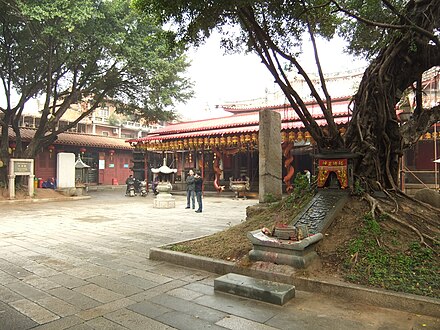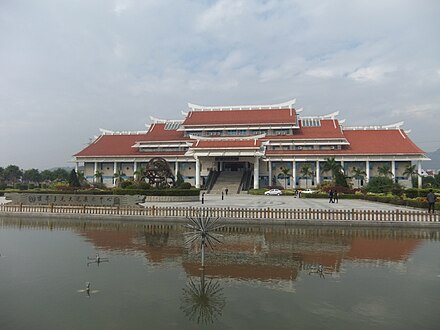Quanzhou - prefecture-level city in Fujian, China
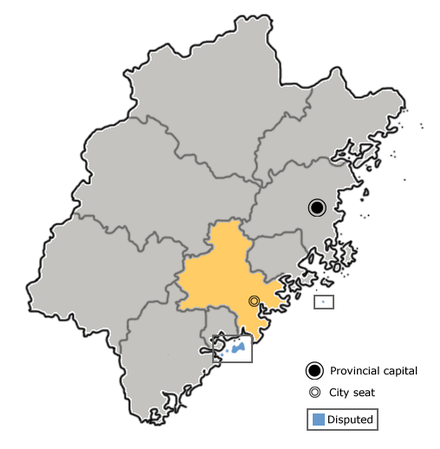 Quanzhou (泉州; Choân-chiu in Minnan, Quánzhōu in Mandarin) is a coastal city in Fujian Province north of Xiamen and south of Fuzhou. Older romanisations, no longer in use, include Ch'üan-chou, Chuanchow and Chinchew.
Quanzhou (泉州; Choân-chiu in Minnan, Quánzhōu in Mandarin) is a coastal city in Fujian Province north of Xiamen and south of Fuzhou. Older romanisations, no longer in use, include Ch'üan-chou, Chuanchow and Chinchew.
Marco Polo sailed home from here around 1292; he called the city by its Arabic and Persian name, Zaiton, and described it as the world's busiest port and stunningly rich. Since then it has come down in the world somewhat, but is still a major port and still quite prosperous. For travellers, much of the history is still quite visible; the town is positively overrun with interesting old buildings.
Most readers from Western countries will never have heard of the city, but they have been somewhat affected by it nonetheless. The English word "satin" comes from "Zaiton", the port from which that fabric first reached the Middle East and thence Europe. The tea that American colonists threw overboard to protest British taxes at the Boston Tea Party was shipped from Quanzhou and grown in nearby Anxi.
Districts
Quanzhou urban area consists of four districts:
- Fengze District (丰泽区; Fēngzéqū)
- Licheng District (鲤城区; Lǐchéngqū)
- Luojiang District (洛江区; Luòjiāngqū)
- Quangang District (泉港区; Quángǎngqū)
Other communities in Quanzhou Prefecture are covered in separate articles: Anxi, Dehua, Hui'an, Jinjiang, Jinmen, Nan'an, Shishi, and Yongchun. Jinjiang is the most important suburb; on the map it is the area south of the river and as of the 2010 census its population was just under two million.
Nearby Xiamen was administered as a district of Quanzhou for centuries, but it grew very rapidly due to foreign trade after it became a treaty port in the 1840s. Today it is a separate city, at least as important as Quanzhou.
Understand
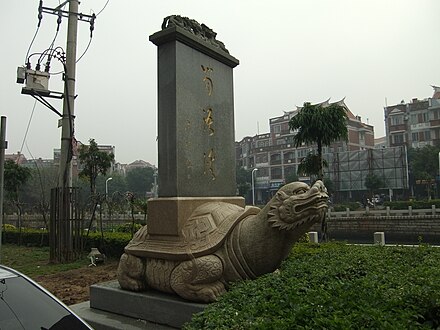
Quanzhou was one of the main bases for the great Chinese treasure ships that routinely traded in Southeast Asia and India and sometimes reached at least as far as Persia and Aden. When Vasco da Gama — sailing the Cape Route to become the first European to reach India by sea — reached East Africa in 1498, he found Chinese trade goods such as blue & white pottery already in the market. The Chinese ships were far larger, longer range, and more advanced technically than European vessels of the period. See Voyages of Zheng He for some of the details.
One writer says that the treasure ships did much more in the early 1400s. He claims they circumnavigated the globe, discovered both Americas decades before Columbus (who used some of their maps, obtained through trade with Egypt), and explored Australia centuries before Europeans arrived. However, his theories are not accepted by most historians.
There is a Maritime Museum in Quanzhou with many relics of this period.
Marco Polo sailed home from Quanzhou about 1292. He described it as the world's busiest port, with Alexandria a distant second. At about that time, Kublai Khan's fleet for the invasion of Japan sailed from Quanzhou. It was wiped out by a storm, the kami kaze or "spirit wind". This is the origin of the name for kamikaze (suicide) pilots during the Second World War; it was hoped they would save Japan in a similar way.
In the 1420s, there was a shift in power in Beijing; the Confucian scholars won out over the eunuchs, and many of the admirals and captains were eunuchs. The emperor cut off all foreign expeditions, destroyed the records of previous voyages, and let the great ships rot. After this, Quanzhou declined considerably. Also, over the centuries the harbour became partly clogged with silt. Today, Quanzhou is less well-known than the provincial capital Fuzhou or booming Special Economic Zone Xiamen, and certainly gets fewer tourists than either. However, it has more historic buildings than either, some interesting modern architecture, and some good shopping.
As the historical centre of the South Fujian region, Quanzhou is also the cradle several traditional art forms, including the Minnan opera genres of Gaojia opera and Liyuan opera, as well as Minnan-style string puppetry.
Like most Chinese cities, Quanzhou has some of the standard 8-storey concrete apartment blocks. However, there are far fewer of those than elsewhere and whole districts are much prettier. The city government has regulations that require new buildings in some areas to follow certain architectural conventions. Downtown, there are many modern 4- to 6-floor buildings with the traditional Chinese tile roofs with points on the corners. Near the old mosque there are new buildings with Islamic themes, such as arched windows, in the architecture. The rebuilding of the Zhongshan Road shopping area got a UNESCO award for heritage preservation, and Quanzhou got an international award in a contest for most livable cities in 2003; neighboring Xiamen had won the previous year. In 2021, 16 sites in and around the city were listed by UNESCO as a world heritage site named "Quanzhou: Emporium of the World in Song-Yuan China".
Talk
The local language is Minnan, which is also spoken in neighbouring Xiamen, as well as across the sea in Taiwan, where it is known as Taiwanese. The dialect in Quanzhou differs slightly from the dialect in Xiamen and Taiwan, but nevertheless, they are similar enough for mutual comprehension. Most locals are bilingual in Mandarin and Minnan, so learning Minnan is not necessary to communicate, though attempts to do so will most certainly impress the locals.
As with elsewhere in China, English is not widely spoken, though staff at more luxurious hotels will usually have at least a basic command of English.
Get in
By plane
- Quanzhou Jinjiang International Airport (泉州晋江国际机场 IATA: JJN), 24.798889°, 118.589444°. Quanzhou, or rather Jinjiang across the river, has an airport with flights to various mainland cities, as well as some international flights to Hong Kong and other Asian cities.
Nearby Xiamen has a more important airport with good domestic connections and quite a few international flights, including several long-haul ones. The Fuzhou airport is also reasonably close.
By train
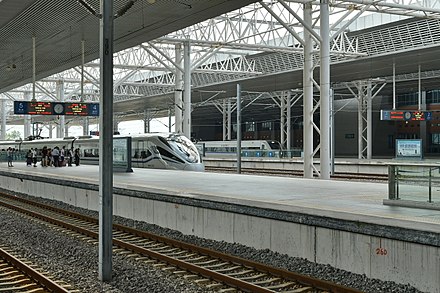
- Quanzhou Station (泉州站), 24.976667°, 118.563056°. The station is served by frequent high-speed trains running on Fujian's coastal high-speed railway between Fuzhou and Xiamen. The line continues north beyond Fuzhou to Wenzhou, Hangzhou, and Shanghai, and south beyond Xiamen to Shantou and Shenzhen. A few trains also go to inland destinations, such as Nanchang in neighbouring Jiangxi province, Wuhan, and points beyond. See High-speed rail in China for details.
There is a bus station in the square outside of the train station, with several local bus routes connecting the station with the city, and suburban routes coming from places such as Chongwu.
Older maps and guidebooks may show the old Quanzhou Railway Station in the northeastern outskirts of the city, off Chenghua South Rd (Hwy G324). This station is closed.
By bus
There are frequent buses from Xiamen (¥27-35, 1½ hours) and Fuzhou (¥46-65, 2½ hours).
There are also direct overnight buses from more distant places such as Hong Kong, Shenzhen and Zhuhai, in the ¥300 range.
There are two main bus stations, a fairly large one in a new building toward the east of town and one that is much more central and looks more run down. The latter is the "new bus station". A small bus station next to the Overseas Chinese Hotel has buses to Fuzhou and Shenzhen.
By boat
There is regular ferry service from Taiwan-controlled Kinmen (Quemoy) Island to the port of Shijing (石井), some 50 km south of downtown Quanzhou. (¥150, or NT$750). However, as of early 2012, only PRC (China) and ROC (Taiwan) citizens can use it. The ferries from Xiamen to Kinmen, however, are open to most nations.
Get around
Taxis start at ¥8 and you can go almost anywhere in town for under ¥20.
Be warned about local traffic! Traffic anywhere in China often horrifies visitors (see Driving in China), but Quanzhou is worse than most places. On some travel blogs, even Chinese complain about Quanzhou traffic.
See
Religious structures
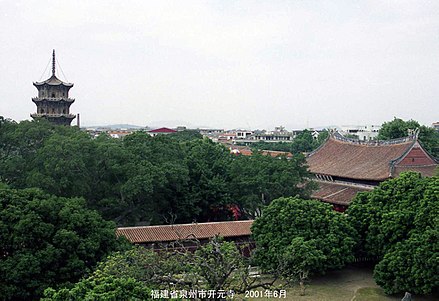 The town has an assortment of religious buildings, some quite old. It has been called a museum of world religions. There are Taoist, Buddhist, and Confucian temples, as anywhere in China, plus Christian churches and one mosque. There are also Hindu and Zoroastrian temples. Neighboring Jinjiang has the world's only surviving Manichean temple.
The town has an assortment of religious buildings, some quite old. It has been called a museum of world religions. There are Taoist, Buddhist, and Confucian temples, as anywhere in China, plus Christian churches and one mosque. There are also Hindu and Zoroastrian temples. Neighboring Jinjiang has the world's only surviving Manichean temple.
- Kaiyuan Temple (开元寺), Xi Jie near Xinhuan Bei Lu, northwest of downtown, 24.9168°, 118.581°. The largest and most famous Buddhist temple complex in the area. The well-landscaped grounds house two famous tall pagodas, several temple buildings, an ancient stone turtle, and a variety of religious art. The Xi Jie (West Lane) outside of the temple is a busy shopping street, with all kind of shops selling souvenirs, joss paper and other Buddhist items, snacks, and books. The Ancient Ships pavilion of the Maritime Museum (whose main building is elsewhere in town; see a separate listing below) is located on the grounds of the temple, in one of its ancillary buildings. ¥10
- Qingjing Mosque (清净寺), Tumen Street, 24.9056°, 118.5869°. The only surviving mosque of the many that used to exist. It is over 1,000 years old, and was rebuilt in 2009 so the dome is now restored after a 200-year absence. Well worth a visit. ¥3
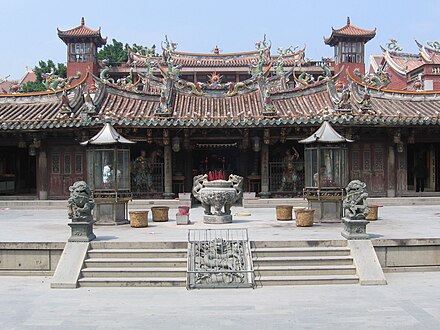
- Guan-Yue Temple (Tonghuai Temple of Guan Yu and Yue Fei (通淮关岳庙)), Tumen Jie 196 (鲤城区涂门街196号) (just east of the mosque), 24.904722°, 118.588333°. A large and impressive Taoist temple. Guan Yu and Yue Fei were generals, and this is a warrior temple, one of many dedicated to them in various parts of China. Note the huge (over 2 stories tall, with a big chimney) ritual furnace for burning joss paper. The furnace becomes very busy around the holidays such Yuanxiao, when people line up to burn their offerings. free 2020-04-07
- Confucian Temple (孔庙). This is the main Confucian temple in town.
- Chongfu Temple, Chongfu Road (northeast of the city center, near where Dong Road turns into Donghu Road). A beautiful if small active Buddhist Temple.
- Old Saint (崇福寺). An enormous statue of Lao Tse, the founder of Taoism, which attracts people from all over China.
- Tian Hou Gong (天后宫), 24.898448°, 118.584367°. Dedicated to Tian Hou ("Heavenly Empress"), also known as Mazu, a sea Goddess worshipped by many sailors and fishermen. Note the ancient bixi turtles with an illegible stele on the temple's grounds, and a pond with fish and turtles in one of the courtyards in the back of the facility. The most important Mazu temple on Earth is on Meizhou Island, in the next city north on the Fujian coast, Putian. Free 2015-10-29
- Six Victories' Tower (六胜塔), Shishi City, 24.810526°, 118.721335°. Six Victories Tower is the study of architecture and art precious kind of Song and Yuan dynasties. The tower is of granite attic type structure, 36.6 m high, around the end of about 47 m, octagonal five layer, the carved Seiko, magnificent, with something comparable to Quanzhou tower.
- Lishan Tombs. The first Islamic missionaries to China came to Quanzhou by ship. Tradition has it that Muhhamad himself sent four of his personal disciples and they arrived in the late 7th century. These are their tombs, a place of pilgrimage for some Muslims. 2020-06-26
Museums
- Quanzhou Museum (泉州博物馆), 24.939261°, 118.581450°, +86 595 2275-7518. 09:00-17:30 (summer), 09:00-17:00 (other seasons). Don't miss a small "stele forest" behind the museum. free
- Puppet Museum. Quanzhou is famous for puppets and the museum is excellent. They sometimes do shows, which are excellent, but not on a regular schedule. You need to be lucky to catch one, or to have a group of 20 or so people and make arrangements. Free
- Fujian-Taiwan Kinship Museum (中国闽台缘博物馆), 212 Beiqing Road East, Fengze District (in a park north of the West Lake, just east of Quanzhou Museum), 24.938599°, 118.585419°, +86 595 2275-1800. Tu-Su 09:00-17:00. Free
- Maritime Museum (泉州外海交通史博物馆), 425 Donghu Jie (泉州市东湖街425号), 24.91023°, 118.61135°. Daily 08:30-17:00. Excellent museum. Quanzhou was, up to the 15th century, one of China's greatest trading cities and a major base for her powerful fleets. Besides a collection of ship models and nautical artifacts, the museum has a large collection of stone inscription and reliefs - from ancient tombstones and temples - demonstrating Quanzhou's historical connections with India, the Middle East, and Europe, and attesting to the presence of Islam, Christianity, Hinduism, and even Manichaeism in the area. Don't miss a collection of stone tombstones and stelae in the back yard. The museum's Ancient Ships Pavilion is on the grounds of Kaiyuan Temple. Free 2015-10-29
- Islamic Culture Exhibition.
- Quanzhou Museum of Overseas Chinese History (泉州华侨历史博物馆), 732 Donghu Street, Fengze District (丰泽区东湖街732号) (opposite East Lake; take bus no. 10, 17, 22, 25, 28, 37, 44, 203, 604 or K502), 24.915057°, 118.602079°, +86 595 22987593, hqg1996@163.com. 09:00-17:00, closed on Mondays. Free 2021-07-27
Other sights

- Luoyang Bridge (洛阳桥), 24.9545°, 118.6762°. A bridge that is considered one of the four ancient bridges of China. Its namesake goes back several centuries, although the railings look remarkably well preserved. But look at the pillars and that may be more indicative of its age.
- Monument to Koxinga (鄭成功; Zhèng Chénggōng). An enormous equestrian statue that appears to be guarding the town, up on a hill on the east side of the city. He was a local boy whose family were seafarers, merchants trading with Japan, and pirates. On land, he became a general, resisting the then-new Qing (Manchu) dynasty. His base on Xiamen's Gulangyu is one of the tourist sites there. Lots of other Koxinga-related sites and monuments can be found in the nearby Kinmen Island, controlled by the Republic of China (Taiwan). Koxinga is best known for driving the Dutch out of Taiwan in the 1660s, the first major wave of Chinese immigration to Taiwan was his soldiers settling down and bringing their families. He is one of the few people seen as a hero by the current governments on both sides of the straits; beating the foreign devils makes you a good guy in everyone's books!
- The residence of the Cai family. The ancient residential buildings by Cai Qichang and his son, Cai senior in the Qing Tongzhi years (1862) to Xuantong three years (1911) built. The existing more complete house in all 16, and are arranged in parallel are orderly distribution to approximately 3 hectares (40 acres) of a rectangular block, 200 meters long and 100 meters wide, covering an area of 15300 m².
Do
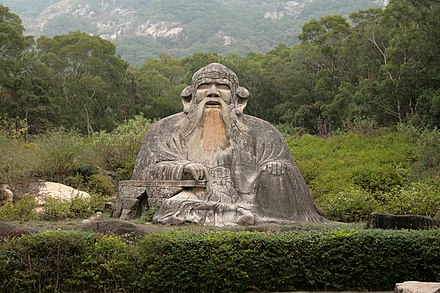
- {{do | name=Qingyuan Mountain 清源山 | alt= | url=http://www.qingyuanmount.com/English/index.asp (dead link: December 2020) | email= | address= | lat= | long= | directions= | phone= | tollfree= | fax= | hours= | price= | content=Climbing this mountain is a nice way to get away from the city, and some of its heat and noise. The Lao Tse statue is located near the main entrance. Mountain climbing in Qingyuanshan is a different experience from hiking in other places, the paths up the mountain (large hill, really) are clearly marked, and paved in most places, with steps up the steeper parts. There are lots of places to buy drinks or snacks along the way, and temples, pavilions, and even some carnival-style games are there to distract you from your trek, if you like. Nonetheless, its a beautiful, strenuous climb, with dense tree canopies above and cicadas all around, with openings along the way with clear vistas of the city below. There is a lake and a dam near the top. Wear good shoes and clothes you can sweat in. }}
- Lantern Festival. The Chinese New Year begins on the first day of the first lunar month; Lantern Festival on the 15th of that month brings the celebration to a close. Lantern Festival is celebrated all over China, but it is a fairly minor event in some places and a rather big deal in others. In Quanzhou, it is huge! Nearly every merchant downtown puts up at least a few lanterns, and they compete to have the best ones. The area around the Confucian Temple is one center of activity, with hundreds of lanterns and thousands of people out to view them. Another major center is down by the river where there is an enormous fireworks show late in the evening.
Buy
Souvenirs
There is large area of antique and curio shops on the north side of the mosque. They sell mainly to locals. Quality, variety and price are all better than most tourist areas. You do have to bargain fiercely, though.
 White pottery from the village of Dehua outside Quanzhou has been a export item for centuries, known in Europe as "Blanc de Chine". Other ceramics are also made in the area. There are kilns going back a millennium or more.
White pottery from the village of Dehua outside Quanzhou has been a export item for centuries, known in Europe as "Blanc de Chine". Other ceramics are also made in the area. There are kilns going back a millennium or more.

Tea
Anxi outside Quanzhou produces one of China's most famous teas, Tieguanyin Oolong. Guan Yin is a Buddhist Bodhisattva sometimes described as the Goddess of Mercy; "tie" means iron. China's three main types of tea are unfermented green tea, partly fermented oolong and heavily fermented Pu'er tea. The best known oolong teas are Tieguanyin, Da Hong Bao from Wuyi Mountain in inland Fujian, and Dongding from Taiwan. Tieguanyin tea is available in countless shops throughout Quanzhou, in most you can sit and try a variety of grades of tea to decide which you want.
Prices for a jin (half kilo) of tea in a typical shop start at about ¥40 and there are some very nice teas under ¥200. However, tea in Chinese culture is priced like wine in the West; a variety that is top quality, rare, or just well-marketed can fetch an amazingly high price. It is not uncommon to see teas at ¥600-2,000 a jin and the record for a rare top-grade tea sold at auction is ¥9,000 a gram. As for wines, a single variety — such as burgundy or tieguanyin — is available in a wide range of grades, the expensive products are best avoided unless you know exactly what you are getting, and most drinkers will be quite happy with lesser types.
Many Quanzhou tea shops also sell the miniature tea sets that are most commonly used in this area; making and drinking tea this way is somewhat labor-intensive (each cup is smaller than a shot glass and a 'pot' is about as big as a coffee cup) but an enjoyable social experience. Making and serving tea in this way is not really a tea 'ceremony' in the sense of a Japanese tea ceremony, but it is still a ritualized and celebrated process.
North of the mosque, across the arched bridge over the small creek (Baguagou), is a traditional courtyard house that has been converted into a teahouse. This is a good place to get an introduction to the local tea service, your server can show you how to prepare the tea. Most tea shops will also be happy to give you an impromptu lesson in brewing tea.
Books and maps
The labirynthine Quanzhou Book City (泉州书城), located underground in Zhongshan Park (Zhongshan North Road, just south of Quanshan Gate), is pretty good for books and maps of all kinds (mostly in Chinese, of course). Lots of provincial atlases from StarMaps "军民双用" ("Military and civil use") series, which are superior to most other publishers' products.
Bicycles
Quanzhou's bike shops of all kinds are concentrated in Zhongshan Nan Lu (Zhongshan South Road). The more southern section, from Tianhou Lu to Yiquan Lu, has primarily electric bike shops. More to the north, from Yiquan Lu to Tumen Lu, regular (pedal) bicycles are found as well, in a at least a dozen shops. There are a few high-end places for various brands, as well as several shops for Chinese mass-market bikes, in the ¥200-500 range. The small family-owned Triace shop at 376 Zhongshan South Road (山南路376号) can be recommended for its friendly and knowledgeable staff. They speak good Mandarin and a bit of English, and can provide local advice and help you get in touch with local bicycle enthusiasts.
Electronics
Need a new iPad? A Chinese cell phone? Some spare parts for your laptop? Computer, cell phone, and electronics shops can be found in Jiuyi St (九一街), west of Wenling Rd. There are also many cell phone shops farther east, as Jiuyi St becomes Fengce Rd (丰泽路).
Learn
The original Shaolin Temple, one of China's greatest centers of kung fu, is in Henan, but during one of China's many wars a lot of the monks fled South and founded Southern Shaolin with three temples in Fujian. The one in Quanzhou, at the foot of Qingyuanshan, dates back to the ninth century; the ones in nearby Putian and Fuqing are even older but are now less active. The Quanzhou temple has been burnt down at least once, but has been rebuilt; it takes foreign students for intensive training at rates (as of 2010) around $500 a month including room and board.
Eat
- {{eat | name=Bart's Kitchen (椰林阁娘惹私房菜) | url=http://www.tooeat.com/vip/index.asp?storeid=189 (dead link: December 2020) | email= | address=at Dong fang min zhu #115 (东方明珠) on Feng zi street (丰泽街) | lat= | long= | directions= | phone= +86 595-22217892 | tollfree= | fax= | hours=09:30-10:30 | price=Expect to ¥20-60 per head | content=Southeast Asian and Western cuisine, with an English menu. }}
- The Mandarin Hotel (悦华酒店). Large lunch (¥160) and dinner (¥270) buffet with both eastern and western dishes.
- Amazon BBQ buffet (亚马逊烤肉), on Ci tong road (刺桐路). All-you-can-eat at moderate prices. Food is generally mediocre, but will hit the spot if you are feeling both hungry and carnivorous; the menu includes lots of meat. They brew their own beer, mostly excellent (the green one tastes like lawn clippings, but gold, red and black are very good) and also moderately priced. There are several locations across town. The lunch buffet is ¥40 and the dinner buffet is ¥60.
- Yuan pan (元番日本料理), on Quan xiu road (泉秀路).. Japanese sushi with buffet prices starting at ¥118.
- Mr. Chiu’s Chiu Chau beef brisket noodles (啊潮牛栏面), on Hu xin jie (湖心街). (heading north on Tian an road (田安北路), turn left on Hu xin jie (湖心街); it'll be on your right). Delicious slow-cooked cubes of beef served in a mild Chinese curry sauce.
- Lan zhou hand-pulled noodles (兰州拉面), on Hu xin street (湖心街) opposite Mr. Chiu's beef noodles.
- French-Vietnamese restaurant (红石), various locations across town (one next to the Puppet Museum behind the Muslim Mosque). High-quality in both decor and food, but high-priced as well.
- Thai-Vietnamese Restaurant (泰好吃), 2 locations in town.
- Xiaolongbao (小龙包), 381 Zhongshan Road (中山路) (slightly south of Yiquan Road (义全街)). More like Shanghai-style San jian bao, with a chewy dough, minced-pork stuffing, and a sweet chili sauce. It is generally ordered alongside a clear soup.
- Little Fat Sheep Hot Pot (小肥羊火锅), several locations across town. A huge chain of Hot Pot restaurants with hundreds of locations across China.
- 淳百味 Chun Bai Wei, On the corner of 新华南路 (Xinhua nan lu) and 新门街 (Xinmen jie). 09:00 - 22:30. A cheap, tasty fill-up with a picture menu. Delicious dumplings (6 for ¥4). Noodle and rice dishes, large portions for ¥5-15. Breakfast available until 10:00, dumplings (bao zi, jiao zi), soya bean milk, dough sticks etc. (Feb 2015) 2015-03-04
There are several vegetarian restaurants near Chengtien Temple on Nanjun Road
- Pu Ti, Nanjun Road (Half a block north of East Street (Dong Jie)).
- Wumingzi (lit.: No Name). Decent, buffet style place.
- Vegetarian Restaurant. Good and quite fancy.
Drink
Bars
- The Brickyard Pub & Cafe, Unit 101, Block 6 Quanxiu Lu, Fengze District, Liveshow Wonderland (地址:泉州市丰泽区泉秀街领秀天地 6号楼101单元 Only a five minute walk from the Yue Hwa Hotel), +86 595 15960431105. 06:00-02:00. A western-style pub & cafe popular with Quanzhou's western expatriate community.
Zhuangyuan Street (Bar Street) is to the east of Zhongshan Road north of the center of town. The street is parallel and slightly south of East Street. It has many bars.
Cafes
- Nicola Coffee (尼姑啦), Next to Hua qiao hotel (华侨大夏). Wen hua gong (文化宫)
Sleep
Quanzhou is not a tourist-oriented city and there are relatively few hotels.
By 2015, a fair number of Quanzhou hosts have registered with airbnb.com.
Budget
There is a hotel attached to the main bus station; turn right as you come out of the station and look for the London/Moscow/Beijing/... row of clocks in the reception area. There are several more hotels along the (fairly long, but walkable) street that leads west from there toward the center of town.
On Wenling Road or Chongfu Road are several cheap business hotels, for ¥50-100.
- Baiyun Hotel (Baiyun Binguan), 157 Zhongshan South Road (slightly north of Mazu Temple), +86 595 22397807. A convenient hotel for cheap travelers. Rooms are relatively large and clean, but fixtures are old so have a careful look at the room first, and ask for a different room if needed. Expect to pay around ¥60 after bargaining
Mid-range
- Carp City Hotel (鲤城大酒店; Licheng Dajiudian), Nanjun Middle Rd (south of Dong St), +86 22279888 (Reception), +86 22279111 (room reservations), +86 22272777 (restaurant reservations). A three-star hotel in a fairly central location. From ¥370 (low season from ¥240)
- Overseas Chinese Hotel, Baiyun Road (across the street from the Culture Park and backing on the Confucius Temple). Check-in: 14:00, check-out: noon. A business hotel with a good range of services in a central location. After bargaining, expect to pay ¥300 for a single
Splurge
Thete are several high-end hotels along Baiyuan Road and nearby streets; they look like palaces and are easy to spot.
- Quanzhou Hotel. Fancy. Excellent but expensive weekend brunch.
- Howard Johnson's.
Connect
The area code for Quanzhou is 595.
Go next
- Bus to Fuzhou leaves from the bus station at the southern end of the main tourist street (not the main bus station) and takes about 3 hours (¥60-70).
- There are also buses to Fuzhou, Xiamen and overnight to Shenzhen from the small station next to the Overseas Chinese Hotel. This will be a convenient location for many travellers, but larger stations have a better choice of routes and departure times.
- Several times a week, there is an early-morning bus to Mount Wuyi and Jingdezhen. This bus is small dirty sleepers, arrives at many of its destinations very late at night, and drops passengers off by the side of the highway rather than the bus station. Consider taking the train instead.
- Chongwu is an old walled town near Quanzhou. There are good beaches near it.
Quanzhou
quanzhou.gov.cnQuanzhou Shi
2nd-order administrative division
Fujian
Primary administrative division
